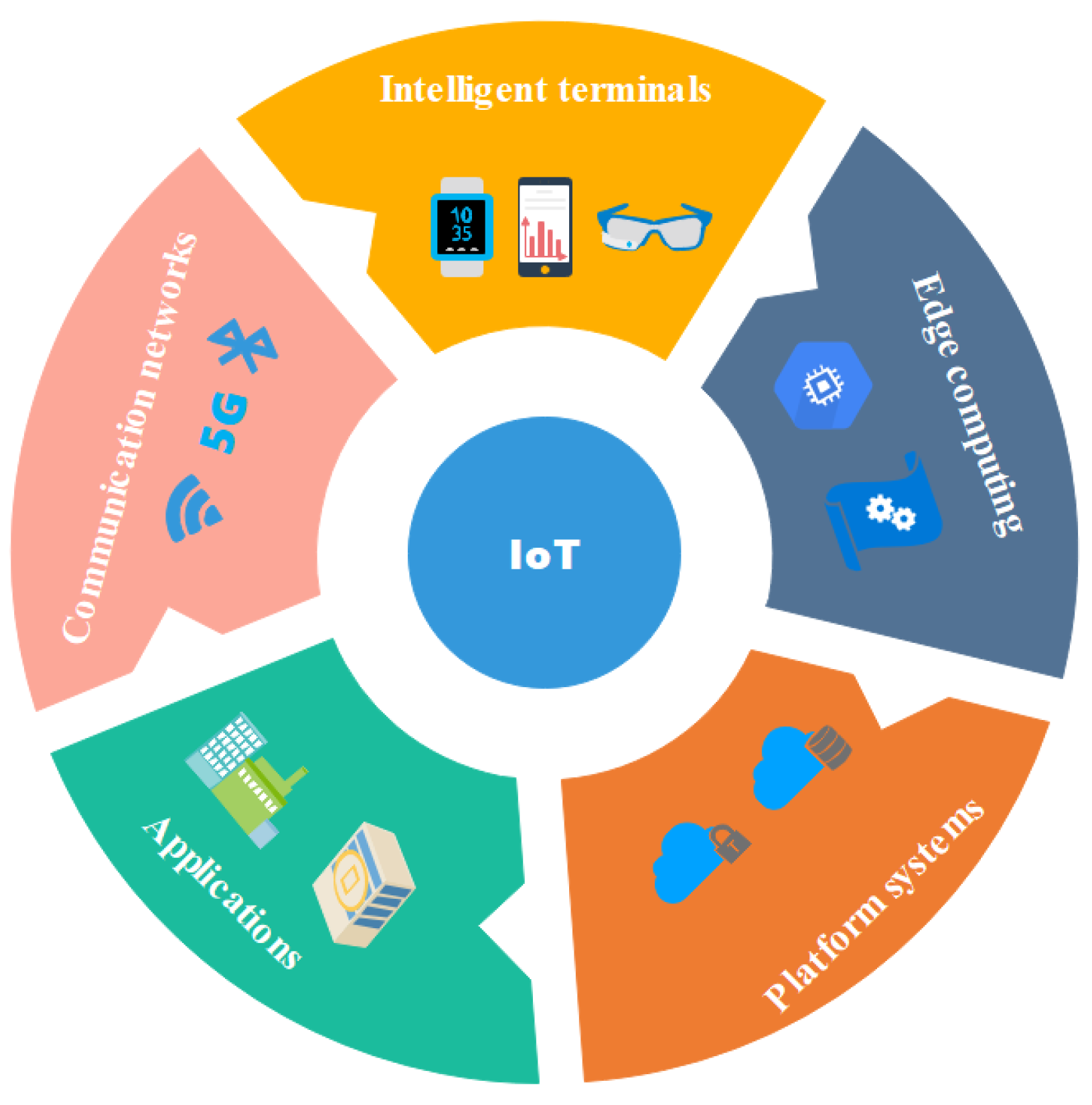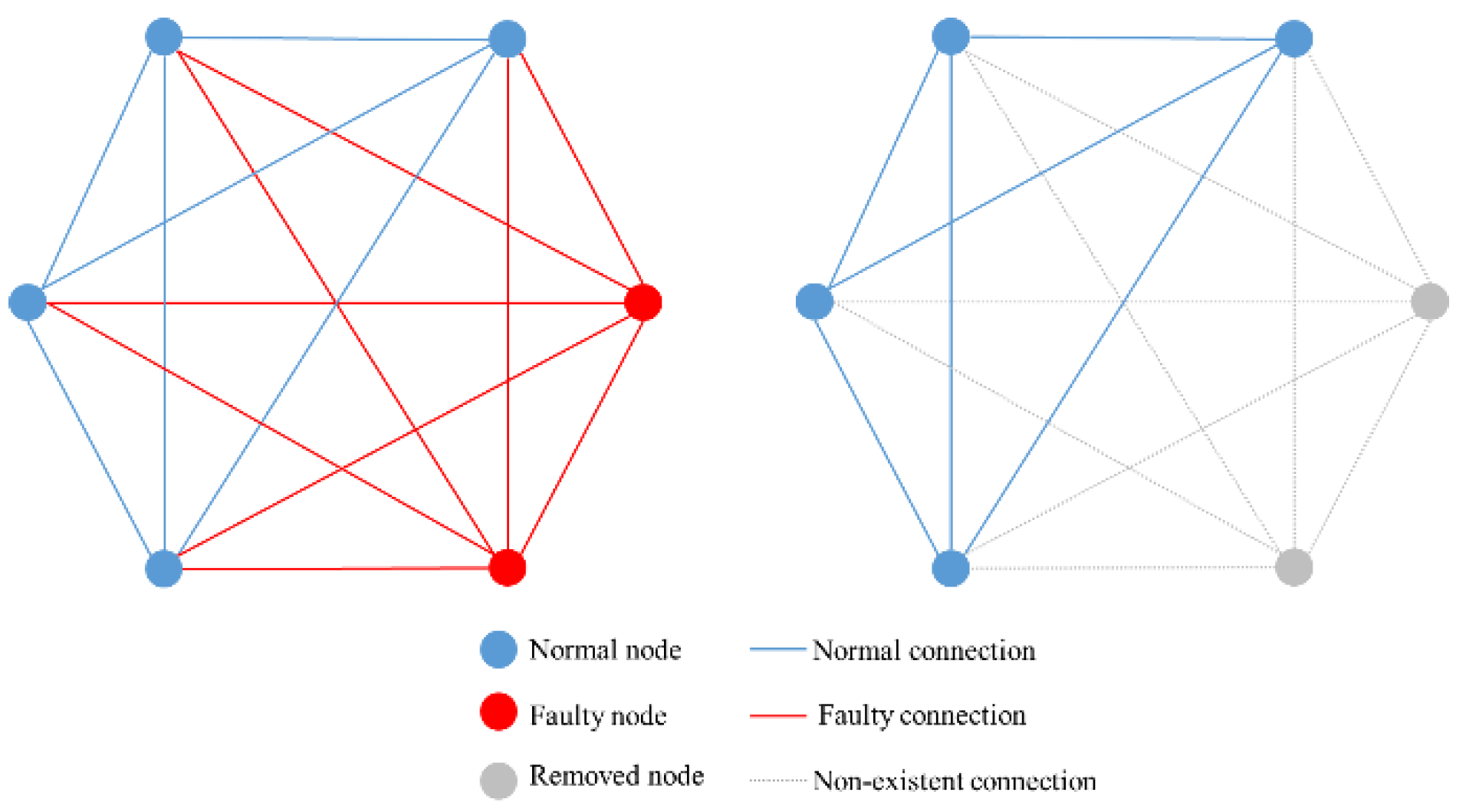IoT Adaptive Dynamic Blockchain Networking Method Based on Discrete Heartbeat Signals
Abstract
1. Introduction
1.1. Motivation
1.2. Current Issues
1.3. Research Contribution
2. Background and Related Work
2.1. Important Definitions of Blockchain
2.2. Distributed System and Heartbeat Monitoring
2.3. BFT Consensus Algorithm
2.4. Related Work
3. Proposed IoT Adaptive Dynamic Blockchain Networking Method
3.1. Fixed-Period Heartbeat Monitoring
3.2. IoT Adaptive Dynamic Blockchain Networking Method Based on Discrete Heartbeat Signals
4. Performance Verification
4.1. The Qualitative Performance Verification by the Physical IoT Node Networking
4.1.1. Test Environment
4.1.2. Network Availability Testing
4.2. The Quantitative Performance Verification by the Blockchain Network Model
4.2.1. Definition of Blockchain Network Status Indicators
4.2.2. Establishment of Large-Scale Node Blockchain Network Risk Model
4.2.3. Parameter Setting and Performance Comparison
4.2.4. Optimization of Expected Recovery Time and Critical Discussion
5. Conclusions
Author Contributions
Funding
Conflicts of Interest
References
- Lu, Y.; Cecil, J. An Internet of Things (IoT)-based collaborative framework for advanced manufacturing. Int. J. Adv. Manuf. Technol. 2016, 84, 1141–1152. [Google Scholar] [CrossRef]
- Stergiou, C.; Psannis, K.E.; Kim, B.G.; Gupta, B. Secure integration of IoT and cloud computing. Future Gener. Comput. Syst. 2018, 78, 964–975. [Google Scholar] [CrossRef]
- Yang, H.; Kim, Y. Design and Implementation of High-Availability Architecture for IoT-Cloud Services. Sensors 2019, 19, 3276. [Google Scholar] [CrossRef] [PubMed]
- Sultan, K.; Ruhi, U.; Lakhani, R. Conceptualizing Blockchains: Characteristics & Applications. arXiv 2018, arXiv:1806.03693. [Google Scholar]
- What is Blockchain Technology? CB Insights Research. Available online: https://www.cbinsights.com/research/what-is-blockchain-technology/ (accessed on 29 June 2020).
- Khan, M.A.; Salah, K. IoT security: Review, blockchain solutions, and open challenges. Future Gener. Comput. Syst. 2018, 82, 395–411. [Google Scholar] [CrossRef]
- Xu, Y.; Wang, G.; Yang, J.; Ren, J.; Zhang, Y.; Zhang, C. Towards secure network computing services for lightweight clients using blockchain. Wirel. Commun. Mob. Comput. 2018, 1–12. [Google Scholar] [CrossRef]
- Sultana, T.; Almogren, A.; Akbar, M.; Zuair, M.; Ullah, I.; Javaid, N. Data Sharing System Integrating Access Control Mechanism using Blockchain-Based Smart Contracts for IoT Devices. Appl. Sci. 2020, 10, 488. [Google Scholar] [CrossRef]
- Lu, Y. The blockchain: State-of-the-art and research challenges. J. Ind. Inf. Integr. 2019, 15, 80–90. [Google Scholar] [CrossRef]
- Azure Blockchain as a Service update, Azure Blog and Updates, Microsoft Azure. Available online: https://azure.microsoft.com/en-us/blog/azure-blockchain-as-a-service-update/ (accessed on 29 June 2020).
- Ultrain White Paper Version 1.1.9. Available online: https://ultrain.info/downloads/Ultrain%20Whitepaper_v1.1.9.pdf (accessed on 29 June 2020).
- Blockchain for Supply Chain, IBM Blockchain, South Africa. Available online: https://www.ibm.com/za-en/blockchain/industries/supply-chain (accessed on 29 June 2020).
- Malkhi, D.; Nayak, K.; Ren, L. Flexible Byzantine Fault Tolerance. In Proceedings of the 2019 ACM SIGSAC Conference on Computer and Communications Security, London, UK, 11–15 November 2019; pp. 1041–1053. [Google Scholar] [CrossRef]
- Jogunola, O.; Ikpehai, A.; Anoh, K.; Adebisi, B.; Hammoudeh, M.; Son, S.-Y.; Harris, G. State-Of-The-Art and Prospects for Peer-To-Peer Transaction-Based Energy System. Energies 2017, 10, 2106. [Google Scholar] [CrossRef]
- What is Blockchain? Oracle Blockchain Platform. Available online: https://www.oracle.com/blockchain/what-is-blockchain.html (accessed on 29 June 2020).
- Stanciu, A. Blockchain Based Distributed Control System for Edge Computing. In Proceedings of the 21st International Conference on Control Systems and Computer Science (CSCS), Bucharest, Romania, 29–31 May 2016; pp. 667–671. [Google Scholar] [CrossRef]
- Hayashibara, N.; Cherif, A.; Katayama, T. Failure Detectors for Large-Scale Distributed Systems. In Proceedings of the 21st IEEE Symposium on Reliable Distributed Systems, Suita, Japan, 13–16 October 2002; pp. 404–409. [Google Scholar] [CrossRef]
- Shostak, R.; Pease, M.; Lamport, L. The byzantine generals problem. ACM Trans. Program. Lang. Syst. 1982, 4, 382–401. [Google Scholar]
- Distributed Systems. Available online: http://book.mixu.net/distsys/ebook.html (accessed on 29 June 2020).
- Castro, M.; Liskov, B. Practical Byzantine fault tolerance. OSDI 1999, 99, 173–186. [Google Scholar]
- TendermInt. Core, Tendermint. Available online: https://tendermint.com/core/ (accessed on 29 June 2020).
- Aublin, P.; Mokhtar, S.B.; Quéma, V. RBFT: Redundant Byzantine Fault Tolerance. In Proceedings of the IEEE 33rd International Conference on Distributed Computing Systems, Philadelphia, PA, USA, 8–11 July 2013; pp. 297–306. [Google Scholar] [CrossRef]
- Larimer, D. DPOS BFT—Pipelined Byzantine Fault Tolerance. Available online: https://medium.com/eosio/dpos-bft-pipelined-byzantine-fault-tolerance-8a0634a270ba (accessed on 29 June 2020).
- Feng, L.; Zhang, H.; Chen, Y.; Lou, L. Scalable Dynamic Multi-Agent Practical Byzantine Fault-Tolerant Consensus in Permissioned Blockchain. Appl. Sci. 2018, 8, 1919. [Google Scholar] [CrossRef]
- Jalalzai, M.M.; Richard, G.; Busch, C. An Experimental Evaluation of BFT Protocols for Blockchains. In Proceedings of the International Conference on Blockchain, San Diego, CA, USA, 25–30 June 2019; pp. 34–48. [Google Scholar] [CrossRef]
- Kim, S.; Kim, J. POSTER: Mining with Proof-of-Probability in Blockchain. In Proceedings of the 2018 on Asia Conference on Computer and Communications Security, Incheon, Korea, 4–8 June 2018; pp. 841–843. [Google Scholar] [CrossRef]
- Tosh, D.K.; Shetty, S.; Liang, X.; Kamhoua, C.; Njilla, L. Consensus protocols for blockchain-based data provenance: Challenges and opportunities. In Proceedings of the 2017 IEEE 8th Annual Ubiquitous Computing, Electronics and Mobile Communication Conference (UEMCON), New York, NY, USA, 19–21 October 2017; pp. 469–474. [Google Scholar] [CrossRef]
- Bashar, G.; Hill, G.; Singha, S.; Marella, P.; Dagher, G.G.; Xiao, J. Contextualizing Consensus Protocols in Blockchain: A Short Survey. In Proceedings of the 2019 First IEEE International Conference on Trust, Privacy and Security in Intelligent Systems and Applications (TPS-ISA), Los Angeles, CA, USA, 12–14 December 2019; pp. 190–195. [Google Scholar] [CrossRef]
- Singh, A.; Click, K.; Parizi, R.M.; Zhang, Q.; Dehghantanha, A.; Choo, K.K.R. Sidechain technologies in blockchain networks: An examination and state-of-the-art review. J. Netw. Comput. Appl. 2020, 149, 102471. [Google Scholar] [CrossRef]
- Wei, J.T.; Lee, M.C.; Chen, H.K.; Wu, H.H. Customer relationship management in the hairdressing industry: An application of data mining techniques. Expert Syst. Appl. 2013, 40, 7513–7518. [Google Scholar] [CrossRef]
- Har-Peled, S.; Sadri, B. How Fast Is the k-Means Method? Algorithmica 2005, 41, 185–202. [Google Scholar] [CrossRef]
- Clustering—Scikit-Learn 0.23.1 Documentation. Available online: https://scikit-learn.org/stable/modules/clustering.html#clustering (accessed on 29 June 2020).





| Proportion of Offline Nodes | 0% | 11.11% | 22.22% | 33.33% | 44.44% | 55.55% | 66.66% | 77.77% | 88.88% |
|---|---|---|---|---|---|---|---|---|---|
| Environment 1 availability | Y | Y | Y | N | N | N | N | N | N |
| Environment 2 availability | Y | Y | Y | Y | Y | Y | Y | Y | Y |
| Environment 3 availability | Y | Y | Y | Y | Y | Y | Y | Y | Y |
| State | Low Risk State | Low to Medium Risk State | Medium Risk State | High Risk State | Paralyzed State |
|---|---|---|---|---|---|
| Offline nodes proportion | 0–5% | 5–15% | 15–30% | 30–33% | 33–100% |
| n | 1 | 2 | 3 | 4 | 5 | 6 |
|---|---|---|---|---|---|---|
| Adaptive dynamic blockchain networking | 67.899% | 99.838% | >99.999% | >99.999% | >99.999% | 100% |
| Fixed-period heartbeat monitoring | 0 | 0 | 0 | 0 | 0 | 100% |
Publisher’s Note: MDPI stays neutral with regard to jurisdictional claims in published maps and institutional affiliations. |
© 2020 by the authors. Licensee MDPI, Basel, Switzerland. This article is an open access article distributed under the terms and conditions of the Creative Commons Attribution (CC BY) license (http://creativecommons.org/licenses/by/4.0/).
Share and Cite
Hu, X.; Zheng, Y.; Su, Y.; Guo, R. IoT Adaptive Dynamic Blockchain Networking Method Based on Discrete Heartbeat Signals. Sensors 2020, 20, 6503. https://doi.org/10.3390/s20226503
Hu X, Zheng Y, Su Y, Guo R. IoT Adaptive Dynamic Blockchain Networking Method Based on Discrete Heartbeat Signals. Sensors. 2020; 20(22):6503. https://doi.org/10.3390/s20226503
Chicago/Turabian StyleHu, Xueyang, Yili Zheng, Yu Su, and Rui Guo. 2020. "IoT Adaptive Dynamic Blockchain Networking Method Based on Discrete Heartbeat Signals" Sensors 20, no. 22: 6503. https://doi.org/10.3390/s20226503
APA StyleHu, X., Zheng, Y., Su, Y., & Guo, R. (2020). IoT Adaptive Dynamic Blockchain Networking Method Based on Discrete Heartbeat Signals. Sensors, 20(22), 6503. https://doi.org/10.3390/s20226503






